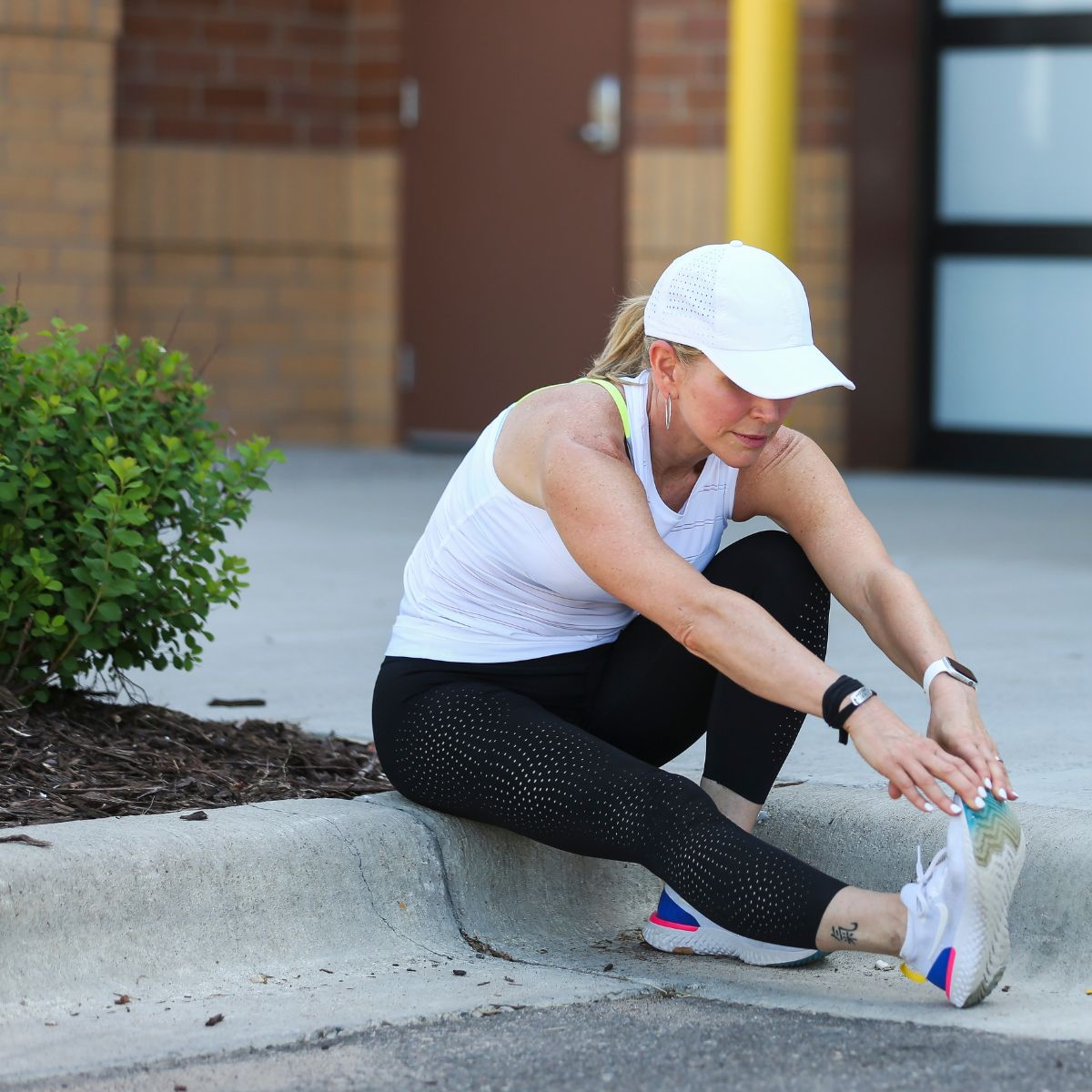In this blog, I’ll dive into why strength training is so important for us as we age and especially as we reach our 40s and beyond.

We’ll look at different types of home exercises you can do and I’ll even give you tips on how to create a personalized routine.
Gain physical and mental empowerment by learning how to stay motivated and create a convenient workout program that you can follow right from the comfort of your own home!
Why Is Strength Training Vital?
As we age, there is a natural decline in muscle mass, strength, and function, known as sarcopenia.
This age-related progressive loss of muscle mass has a few impacts on our overall health and well-being… and it’s not the best news!
- Sarcopenia: This is the term used to describe the involuntary age-related loss of muscle mass and strength and is one of the most significant effects of aging on muscle tissue [Source: PMC].
- Symptoms and Causes: The main symptom of sarcopenia is muscle weakness. This condition results from factors like hormonal changes, decreased physical activity, and poor nutrition. [Source: Cleveland Clinic].
- Age-Related Muscle Loss: After the age of 30, people experience a gradual decline in muscle mass that can range from 3% to 5% per decade. [Source: Harvard Health].
- Slowing the Decline: While muscle mass loss is a natural part of the aging process, there are ways to slow down this decline. Regular exercise, particularly resistance training, and a healthy, protein-rich diet can help preserve muscle mass as women age. [Source: Tufts University]
- Sarcopenia and Resistance to Growth Signals: As we age, our bodies become less responsive to growth signals, leading to muscle loss. But living an active lifestyle and following a healthy diet, can help really combat this process! Let’s Do it!!! [Source: Healthline]
*** It’s important to note that this is a general overview of muscle mass loss in women as we age. Each of our experiences may vary, so consulting with your healthcare professional is always recommended for personalized advice and guidance.
So in addition to reducing the effects of sarcopenia, strength training:
- is a great way for us to maintain and improve our physical health.
- offers weight loss benefits.
- increases bone density (which is so important) as we’re more susceptible to osteoporosis.
- reduces the occurrence of falls and fractures.
- improves our grip strength (a serious factor and consequence when getting older).
- helps to tone our bodies.
- builds our endurance and increases strength.
- And finally, includes all the benefits of general regular exercise like managing stress and anxiety better, and improved sleep, mood, and energy levels.
P.S. considering the importance of grip strength, you may want to consider investing in a tennis ball to squeeze or some hand grips.
Starting Out – Which Strength Training Equipment is Best For You
Starting out with strength training can feel overwhelming because we hear so many rules about… repetitions and starting slow, proper form, plus- how to use them safely, and what muscle groups and how often? etc. etc.
So, oftentimes (for me at least) it seemed so much easier to just- do cardio- walking, swimming, low-impact workouts!
But I know that strength training is especially crucial for our balance, safety, independence, and strength when aging. So.
First:
- Choose equipment that’s safe and comfortable for your body.
- Start with equipment that feels manageable and build up from there.
- Keep in mind your personal fitness goals and limitations.

And, let’s have a look at some of your options:
1.) Dumbbells
Dumbbells increase strength and tone your muscles and are a classic piece of workout equipment.
One of the great things about dumbbells is their versatility –
- they can be used to target different muscle groups, from bicep curls to squats to chest presses.
- they’re inexpensive.
- they come in a range of weights, so you can choose the right level of resistance for your goals and fitness level.
- they’re compact and easy to store.
Dumbbells may be simple, but they’ve earned their place in the gym as a reliable tool for building strength and power!
2.) Resistance Bands
Resistance bands are the ultimate workout tool for building strength and toning their muscles.

Unlike traditional weights, these bands are lightweight, portable, and versatile, and you can use them for bicep curls, squats, lunges, and even yoga poses.
The best part?
They offer constant resistance throughout the entire range of motion, so they’re great for targeting specific muscle groups and achieving better results.
3.) Calisthenics
Calisthenics is a type of exercise that doesn’t require weights or equipment.
It relies on using your own body weight and gravity, to build strength and increase endurance.
And psst.. some seriously ripped bods can result from this form of exercise! :,)
This type of workout is low impact, includes many types of exercises, and can be done anywhere-
your living room, your workout room, basement, patio, anywhere- !
You’ll have to start slow, but it’ll provide a challenging workout that’ll leave you feeling accomplished and strong at all levels.

4.) Kettle Balls
Kettlebells are an effective, popular form of strength training that provide a combination of cardiovascular, flexibility, and strength-based movements for a full-body workout.
Kettlebells can be used to target any muscle group, but they’re especially great for working the core and back muscles because of their unique shape and weight distribution.
And of course, there are also calisthenics towers (we purchased this tower and my husband likes it) and resistance-designed exercise machines which I examine here:
The 6 Best Exercise Machines for Your Home Gym
Setting Up a Home Gym
There are so many benefits to a home gym!
Here’s a snippet from my previous article:

“Home gyms allow you to:
- Create custom workouts, tailored to your own pace and fitness goals.
- Invest in equipment that meets your specific needs, whether that’s buying a few key pieces or building a full-fledged garage or basement gym.
- Be more cost-effective since you won’t have to pay membership fees or monthly dues.
- Exercise in the comfort, convenience, and safety of your own home without having to worry about the time, queues, weather, transportation, judgy eyes, etc.
With so many benefits, it’s hard to beat the convenience and customizability that a home gym can provide.”
Getting Started On A Personalized Home Routine
If you’re looking to create a personalized strength training routine at home, here are some great tips to help you get started:

- Set goals: Before starting any workout routine, it’s essential to set reasonable and achievable fitness goals. This’ll help you determine the type of strength training exercises that’ll be most effective for you.
- Choose equipment: You can decide which equipment you want to use based on what you’d like to achieve and your budget. Dumbbells and resistance bands are probably the best options for at-home workouts.
- Create a workout plan: and stick to it! You can do your workouts in the morning, afternoon, or evening- whatever works best. Make sure to include cardio and strength training in your routine and research online for pre-made workout plans, or invest in a personal trainer to create a plan that suits you. *See below.*
- Start with a proper warm-up: Proper warm-ups are a must before any workout. Dynamic stretching and light cardio increase blood flow to your muscles and loosen your joints.
- Use proper form: Proper form during exercises is also a must for avoiding injury and getting the most out of your workout. Keep your spine in a neutral position and engage your core while using controlled movements.
- Gradually increase weight and resistance: This can help prevent injury and build strength over time. Starting with lighter weights and gradually increasing as you get stronger is very important.
- Stay hydrated: Drink! Drink! Drink! Make sure to drink water before, during, and after your workouts.
- Create ambiance: Have a space in your home just for your workouts. Make sure the lighting is bright, the music is motivating, and you’ve got everything you need for fun, awesome workout sessions!
Strength Training Over 40: A 6-Week Program to Build Muscle and Agility
Weight Training Exercises You Can Do at Home
Here’s a list of specific weight training exercises you can do at home that use both equipment and body only:
- Dumbbell squats
- Bicep curls with dumbbells or resistance bands
- Dumbbell floor press
- Hammer curls
- High knees (not for me!!!)
- Chest press with dumbbells or resistance bands
- One-arm row with dumbbells or resistance bands
- Overhead press with dumbbells or resistance bands
- Kickback with dumbbells or resistance bands
- Deadlift with dumbbells or resistance bands
- Lunges with or without dumbbells
- Squat to overhead raise with dumbbells or resistance bands
- Plank rows with dumbbells
- Pushups
- Mountain climbers (nope, not for me either, lol!)
These exercises are effective for building strength and can be modified based on your fitness level and equipment availability.
For example, I personally can’t do anything that requires any jumping movements, at all, due to my physical restrictions.
I have to be careful that any workout I do is low-impact, preferably standing or sitting, and that I’m always holding my core tight.
Remember

Though we touched on it above, it’s worth repeating.
To avoid injury during strength training:
- Start with a proper warm-up that includes stretching and light cardio.
- Use proper form during exercises to prevent strain on your joints and muscles, keeping your spine neutral and core engaged.
- Gradually increase weight and resistance as you become stronger instead of starting with heavy lifting right away.
Following these tips will help you stay safe and reach your strength training goals.
As an Amazon Associate, I earn from qualifying purchases.
And that’s it!
Best of luck to you in your strength training endeavors!!!
As an Amazon Associate, I earn from qualifying purchases.
#Started #Home #Ledoux #Lagoon








.JPG)




















